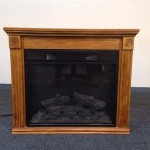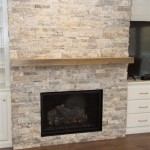The Enduring Appeal of a Craftsman Fireplace Mantel
The Craftsman style, a movement born from the late 19th and early 20th centuries, continues to exert a powerful influence on home design. Characterized by simplicity, functionality, and a deep respect for natural materials, the style offers a comforting antidote to the excesses of Victorian ornamentation. A prominent feature in many Craftsman homes is the fireplace, often anchored by a meticulously crafted mantel. A Craftsman fireplace mantel is more than just a decorative element; it is a focal point, a statement of values, and a testament to the enduring principles of thoughtful design.
The defining characteristics of a Craftsman fireplace mantel are rooted in the movement’s core tenets. These mantels prioritize clean lines, minimal ornamentation, and the honest expression of materials, typically wood. Unlike the elaborate carvings and gilded surfaces of earlier styles, a Craftsman mantel emphasizes the inherent beauty of the wood grain and the joinery techniques used in its construction. This focus creates a sense of warmth, authenticity, and an understated elegance that resonates with homeowners seeking a connection to simpler times.
Key Elements of Craftsman Fireplace Mantel Design
Several key design elements contribute to the distinctive character of a Craftsman fireplace mantel. Understanding these elements is crucial for anyone seeking to incorporate this style into their home or to appreciate the nuances of existing Craftsman mantels.
Material Selection: The choice of wood is paramount in crafting a genuine Craftsman mantel. Oak, particularly quarter-sawn oak, is a classic selection, showcasing a distinctive grain pattern and inherent strength. Other common choices include cherry, maple, and mahogany, chosen for their rich tones and durability. The emphasis is always on showcasing the natural beauty of the wood, often with a clear finish or a light stain that allows the grain to shine through. Reclaimed wood is also becoming increasingly popular for Craftsman-style mantels, offering a sustainable and historically resonant option.
Simplicity of Form: Craftsman mantels adhere to a philosophy of "form follows function." This translates into clean, straight lines and a geometric approach to design. Elaborate curves and excessive ornamentation are eschewed in favor of simple, well-defined shapes. The mantel shelf is typically a prominent element, providing a functional surface for displaying decorative objects. The legs or supports of the mantel are often substantial and square or rectangular, reflecting the solidity and permanence associated with the style.
Joinery and Construction: The quality of the joinery is a hallmark of a well-crafted Craftsman mantel. Mortise and tenon joints, dovetail joints, and other traditional woodworking techniques are frequently employed to create strong, durable, and visually appealing connections. Exposed joinery, where the joints are deliberately visible, is sometimes used to showcase the craftsmanship and attention to detail. This honest expression of construction is a key element of the Craftsman aesthetic.
The Role of the Fireplace in Craftsman Interiors
The fireplace occupies a central role in the design and function of a Craftsman home. It is more than just a source of heat; it is a gathering place, a symbol of domesticity, and a focal point that defines the character of the living space. The fireplace mantel, therefore, plays a crucial role in reinforcing these symbolic associations.
The placement of the fireplace is often strategic, typically located in the living room or family room, where it serves as the heart of the home. The mantel provides a natural stage for displaying personal belongings, family photographs, and other objects that reflect the inhabitants' values and interests. This personalization reinforces the sense of warmth and belonging associated with the fireplace and the Craftsman style in general.
The scale and proportions of the mantel are carefully considered in relation to the size of the room and the overall architectural style of the house. A well-designed Craftsman mantel complements the space without overwhelming it, creating a sense of balance and harmony. The mantel's design often incorporates elements that echo other architectural details in the room, such as built-in bookcases, window trim, and wainscoting, further unifying the interior design.
The fireplace surround, the area immediately surrounding the firebox, also contributes to the overall aesthetic. Common materials for fireplace surrounds in Craftsman homes include brick, tile, and stone. These materials are chosen for their durability, natural textures, and ability to complement the wood of the mantel. The use of earthy tones and muted colors further reinforces the grounded and naturalistic feel of the Craftsman style.
Adapting the Craftsman Mantel for Modern Homes
While rooted in a specific historical period, the Craftsman style remains highly adaptable to contemporary homes. The principles of simplicity, functionality, and natural materials are timeless and can be integrated into a wide range of architectural styles. A Craftsman fireplace mantel can add a touch of warmth and character to a modern living space, creating a welcoming and inviting atmosphere.
When incorporating a Craftsman mantel into a modern home, it is important to consider the overall design context. The mantel should complement the existing architectural features and interior design elements, rather than clashing with them. This often involves simplifying the design and adapting the materials to suit the modern aesthetic.
For example, a modern Craftsman mantel might feature a cleaner, more minimalist design with less emphasis on exposed joinery. The wood might be stained in a lighter tone or even painted white to create a brighter and more contemporary look. The fireplace surround might be made of sleek, modern materials such as glass or stainless steel, creating an interesting contrast with the natural wood of the mantel.
Another approach is to incorporate Craftsman-inspired details into an existing fireplace mantel. This might involve adding simple trim work, replacing the mantel shelf with a wider and more substantial piece of wood, or incorporating decorative tiles with geometric patterns. These subtle changes can transform a generic fireplace into a focal point that reflects the Craftsman aesthetic.
Ultimately, the key to successfully adapting the Craftsman mantel for modern homes is to embrace the core principles of the style – simplicity, functionality, and natural materials – while adapting the specific details to suit the contemporary context. This allows homeowners to enjoy the warmth and character of the Craftsman style without sacrificing the clean lines and modern sensibilities of their homes.
The enduring popularity of the Craftsman fireplace mantel speaks to its timeless appeal and versatility. It is a testament to the power of thoughtful design and the enduring relevance of principles that prioritize simplicity, functionality, and the honest expression of materials. Whether in a historic Craftsman bungalow or a contemporary urban loft, a well-crafted mantel can transform a simple fireplace into a focal point that adds warmth, character, and a touch of timeless elegance to any living space.

Fireplace Mantel Floating Shelf Vintage Craftsman Finish Victorian Design We Are Very Passionate About Our 100 Satisfaction Rating

The Craftsman Fireplace A Standout Fire Space

Pin By Merri Anne Sullivan On Manifesting Our 2024 Craftsman Fireplace Remodel Brick

Simply Seven Craftsman Fireplace Mantels That Will Make You Drool Medium Tile Surround Remodel Bedroom

Home Improvement Build Your Own Fireplace Mantel Hearth Craftsman Style Make It Love

Most Popular Fireplace Tiles Ideas This Year You Need To Know Best Design Fir Craftsman Mantels Style Tile Surround

White Craftsman Mantel And Shiplap Wall Makeover Her Tool Belt
Mantels Surrounds Mitre Contracting Inc

Craftsman Style Mantel Windsorone

Heating Things Up Craftsman Fireplaces
Related Posts








